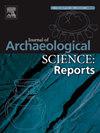Morphometric analysis of the front-view human figures in the Ningming Huashan Rock Art, Southern China
IF 1.5
2区 历史学
0 ARCHAEOLOGY
引用次数: 0
Abstract
The Zuojiang rock art group is a World Cultural Heritage area, of which the Ningming Huashan Rock Art site (NHRA), in Ningming County, Chongzuo City, Guangxi Zhuang Autonomous Region, is considered to be a representative locality. However, the NHRA is located on the steep cliffs facing the Zuojiang River making accessibility to analyze the rock art images extremely difficult. Most of the previous studies have focused on understanding the age, content, function and techniques used to create the rock art. However, given its inaccessibility, any previous attempts to analyze the rock art based on metric dimensions have failed. Here we present for the first time a metric analysis of 179 intact human figures from the NHRA that have been measured (height, image height (including head ornaments), arm width, leg width, arm span, leg span, torso height, chest width, area) using close range photogrammetry technology to obtain detailed data of the size, distribution range and compositional proportion of the human figures. The results show that the height, image height, arm span and leg span of the human figures are mostly distributed between 100–150 cm. Overall, it represents a Gaussian distribution. The torso height, arm and leg width are between 50–100 cm, chest width is between 20–30 cm, and area is between 0.3–0.4 m2. Detailed features of the head, hands, feet, and torso were also classified and numeric data were recorded which allowed for statistical analyses. Pearson’s correlation test results show that there is a significant correlation between the height and eight measurements indicating that the images follows the rules of proportionality and coordination, which in turn suggests that the painters are skilled at the creation of rock art. The results of this study are important for exploring the forms of organization within the social groups of the painters regarding the production, learning and diffusion of rock art. This study will shed further light on the variability of human figure rock art across southwest China and Southeast Asia.
中国南方宁明花山岩画正面人像的形态计量分析
左江岩画群是世界文化遗产,其中位于广西壮族自治区崇左市宁明县的宁明花山岩画遗址(NHRA)被认为是一个具有代表性的地点。然而,宁明花山岩画位于陡峭的悬崖峭壁上,面临左江,因此分析岩画图像非常困难。以往的研究大多侧重于了解岩画的年代、内容、功能和创作技术。然而,由于交通不便,以往任何基于度量尺寸分析岩画的尝试都以失败告终。在此,我们首次介绍了对 179 个来自国家考古研究院的完整人像的度量分析,这些人像利用近距离摄影测量技术进行了测量(高度、形象高度(包括头部装饰)、臂宽、腿宽、臂跨、腿跨、躯干高度、胸宽、面积),以获得人像的尺寸、分布范围和构成比例的详细数据。结果显示,人物的身高、像高、臂展和腿展大多分布在 100-150 厘米之间。总体而言,呈高斯分布。躯干高度、臂宽和腿宽在 50-100 厘米之间,胸宽在 20-30 厘米之间,面积在 0.3-0.4 平方米之间。此外,还对头部、手部、脚部和躯干的详细特征进行了分类,并记录了数字数据,以便进行统计分析。皮尔逊相关性检验结果表明,身高和八项测量值之间存在显著相关性,表明图像遵循了比例和协调的规则,这反过来又表明画家在岩画创作方面技艺娴熟。这项研究的结果对于探索岩画制作、学习和传播方面的社会群体组织形式具有重要意义。这项研究将进一步揭示中国西南地区和东南亚地区人物岩画的变异性。
本文章由计算机程序翻译,如有差异,请以英文原文为准。
求助全文
约1分钟内获得全文
求助全文
来源期刊

Journal of Archaeological Science-Reports
ARCHAEOLOGY-
CiteScore
3.10
自引率
12.50%
发文量
405
期刊介绍:
Journal of Archaeological Science: Reports is aimed at archaeologists and scientists engaged with the application of scientific techniques and methodologies to all areas of archaeology. The journal focuses on the results of the application of scientific methods to archaeological problems and debates. It will provide a forum for reviews and scientific debate of issues in scientific archaeology and their impact in the wider subject. Journal of Archaeological Science: Reports will publish papers of excellent archaeological science, with regional or wider interest. This will include case studies, reviews and short papers where an established scientific technique sheds light on archaeological questions and debates.
 求助内容:
求助内容: 应助结果提醒方式:
应助结果提醒方式:


